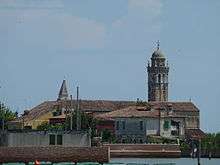Mazzorbo
Mazzorbo is an island with about 270 residents (2017) in the northern Venetian Lagoon.
Understand
It was once an important trading centre but is now known for its vineyards and orchards.
To the southeast it overlooks the marsh of Santa Caterina and to the west on the Monte swamp. To the northwest the Mazzorbo canal divides it from Mazzorbetto, while the northeast side is the Burano canal.
It has a vaguely rectangular shape, with the major side of about 900 m. It is crossed by only two internal canals: the Santa Caterina canal winds at the western end, passing in front of the church of the same name, and cuts the island from side to side; the other opens in front of Burano.
The landscape is characterized by the presence of cultivated areas on which traditional fruit and vegetable activities (such as the cultivation of castraure) take place, similarly to other islands in the lagoon.
History
Formerly known as Maiorbo and Maiurbo it was populated by the inhabitants of the mainland fleeing from Barbarian invasions and particular by the Lombards that between the sixth and seventh centuries.
Archaeological finds prove that the island was frequented in earlier times: small pots of Mycenean invoice were found (today preserved at the Provincial Museum of Torcello) that show that the area was subject to trade in pre-Roman times.
It was one of the inhabited areas around the important commercial center of Torcello, and at least since 1064 it was the site of a parish under the bishop of Torcello.
It achieved its maximum splendor in the tenth century. After the year 1000 Mazzorbo, like the neighboring centers, began to decline in favor of nearby Venice. It thus became a "country" island, used for agricultural activities and a place for leisures for the Venetian patricians.
Nothing remains of the ancient Mazzorbo today, except for the church of Santa Caterina built between 1283 and 1291. Its bell is the oldest in the Lagoon (1318).
In the 1980s, the Italian architect Giancarlo De Carlo designed and built a residential complex in Mazzorbo to repopulate the island and recreate, through a modern language, the typical traditional spaces of the lagoon settlement.
In ancient times, the island of Mazzorbo had as many as five parish churches and six monasteries. From the pastoral visits made by the bishops of Torcello, we know that in the 17th century there were two parish churches on the island - San Pietro and Sant'Angelo - and three monasteries - Santa Caterina, Santa Maria in Val Verde and Sant'Eufemia. St. Peter and St. Eufemia were actually in Mazzorbetto, but it was considered an integral part of Mazzorbo. Apart from Santa Maria in Val Verde, founded in the 13th century, all the others are mentioned in the manuscript 768 kept at the Provincial Museum of Torcello, which lists the religious buildings on the island in the 12th century .
The only remaining religious building is the church of Santa Caterina (the adjoining monastery has disappeared), the current parish church. Di Sant'Angelo remains instead the bell tower, near the northeastern corner of the island.
Get in
It is linked to Burano by a bridge.
Get around
See

Its main attraction is the 14th-century Church of Santa Caterina, and there is also a brightly painted housing development, designed in 1979 by Giancarlo De Carlo.
Do
Buy
Eat
- Alla Maddalena, Fondamenta Santa Caterina Mazzorbo 7/b, ☎ +39 041730151. F-Tu 08:00-20:30, W 08:00-18:00. Right by the boat stop just before you reach Burano.